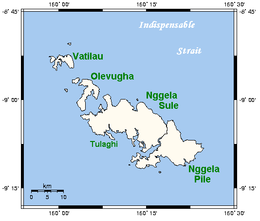Tulagi
This articleneeds additional citations forverification.(February 2008) |
 The Nggela islands group, with Tulagi off the south coast of Nggela Sule | |
| Geography | |
|---|---|
| Location | South Pacific |
| Coordinates | 9°06′05″S160°08′48″E/ 9.10139°S 160.14667°E |
| Archipelago | Nggela Islands |
| Area | 2.08 km2(0.80 sq mi) |
| Length | 2.8 km (1.74 mi) |
| Width | 0.8 km (0.5 mi) |
| Highest elevation | 100 m (300 ft) |
| Administration | |
| Province | Central |
| Demographics | |
| Population | 1,251 (2009) |
Tulagi,less commonly known asTulaghi,is a small island inSolomon Islands,just off the south coast ofNgella Sule.The town of the same name on the island (pop. 1,750) was the capital of theBritish Solomon Islands Protectoratefrom 1896 to 1942 and is today the capital of theCentral Province.The capital of what is now the state of Solomon Islands moved toHoniara,Guadalcanal,afterWorld War II.
The island was originally chosen by the United Kingdom as a comparatively isolated and healthier alternative to the disease-ridden larger islands of theSolomon Islands archipelago.
In October 2019, the government of Central Province signed a deal to grant the 75-year lease of the entire island of Tulagi to a Chinese company China Sam Enterprise Group.[1]However, this was declared unconstitutional by the Solomon Islands parliament after a week and, consequently, the deal was cancelled.
Climate[edit]
| Climate data for Tulagi | |||||||||||||
|---|---|---|---|---|---|---|---|---|---|---|---|---|---|
| Month | Jan | Feb | Mar | Apr | May | Jun | Jul | Aug | Sep | Oct | Nov | Dec | Year |
| Mean daily maximum °C (°F) | 31 (88) |
31 (88) |
31 (88) |
31 (88) |
31 (87) |
30 (86) |
30 (86) |
30 (86) |
30 (86) |
31 (87) |
31 (88) |
32 (89) |
31 (87) |
| Mean daily minimum °C (°F) | 24 (76) |
24 (76) |
24 (76) |
24 (76) |
24 (76) |
24 (75) |
24 (75) |
23 (74) |
24 (76) |
24 (76) |
24 (76) |
24 (76) |
24 (76) |
| Averageprecipitationmm (inches) | 360 (14.3) |
400 (15.8) |
64 (2.5) |
51 (2) |
210 (8.1) |
170 (6.8) |
190 (7.6) |
220 (8.7) |
200 (8) |
220 (8.7) |
250 (10) |
260 (10.4) |
2,560 (100.9) |
| Source: Weatherbase[2] | |||||||||||||

History[edit]
The first recorded sighting by Europeans was by the Spanish expedition ofÁlvaro de Mendañaon 16 April 1568. More precisely the sighting was due to a local voyage done by a small boat, in the accounts thebrigantineSantiago,commanded byMaestre de CampoPedro Ortega Valenciaand havingHernán Gallegoas pilot.[3][4]
World War II[edit]
TheJapaneseoccupied Tulagi on May 3, 1942, with the intention of establishing aseaplanebase nearby (seeJapanese Tulagi landing). The ships in Tulagi harbor were raided by planes fromUSSYorktownthe following day in a prelude to theBattle of the Coral Sea.
Allied forces, primarily the 1stMarine Raiders,landed on August 7 and captured Tulagi as part ofOperation Watchtowerafter a day of hard fighting.
After its capture byUnited States NavyandMarine Corps forces,the island hosted a squadron ofPT boatsfor a year, which includedLTJGJohn F. Kennedy'sPT-109as well as other ancillary facilities. A small 20-bed dispensary was operated on Tulagi until its closure in 1946. The island also formed part ofPurvis Bay,which hosted many US Navy ships during 1942 and 1943.
Postwar[edit]
The present-day Tulagi has afishing fleet.
Scuba diving[edit]
Tulagi offers numerousscuba divinglocations. The wrecks ofUSSAaron Ward,USSKanawha,andHMNZSMoaare close by, and the wrecks ofIronbottom Soundare not much further off, to the south and west. These three ships were all sunk in the same Japanese naval air raid, part of the Operation "I" on April 7, 1943. TheWardlies upright and intact, its deck replete with artifacts, on a sandy bottom at 70 metres (230 feet).
Tulagi is developing atourism industrybased on scuba.[citation needed]
References[edit]
- ^"Chinese Lease of Entire Island Is Deemed Illegal in Solomons".The New York Times.24 October 2019.
- ^ "Weatherbase: Historical Weather for Tulagi, Solomon Islands".Weatherbase. 2011. Retrieved on November 24, 2011.
- ^Sharp, Andrew (1960).The discovery of the Pacific Islands.Oxford. p. 45.
- ^Brand, Donald D.The Pacific Basin: A History of its Geographical ExplorationsThe American Geographical Society, New York, 1967, p.133.

